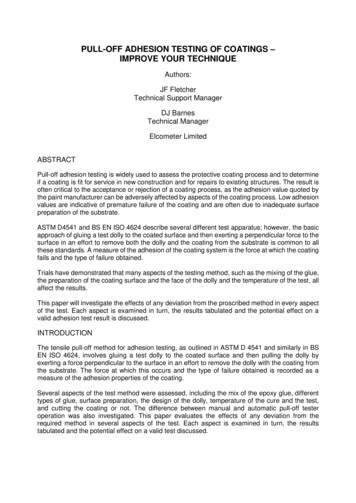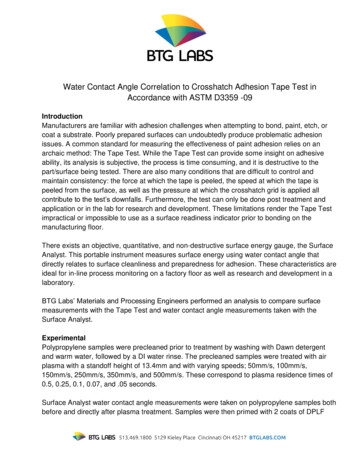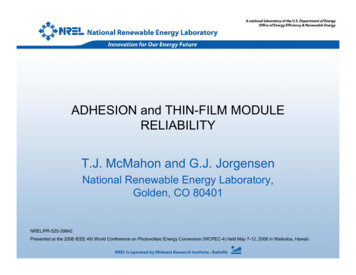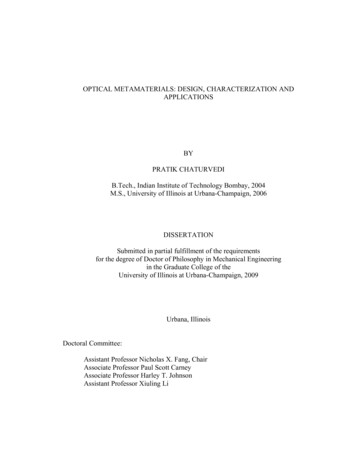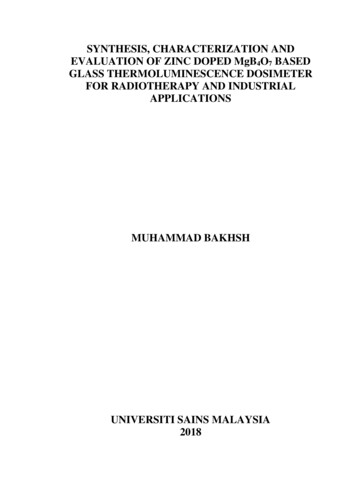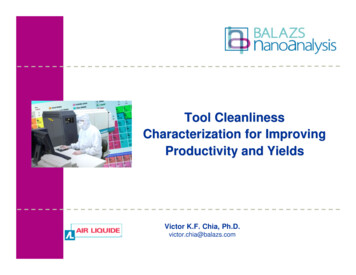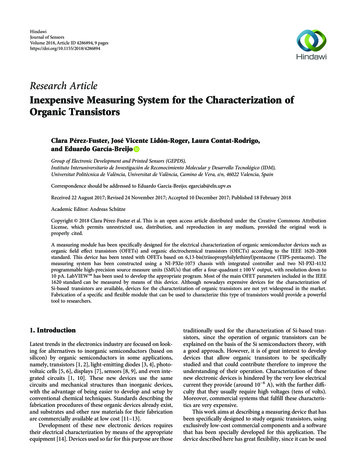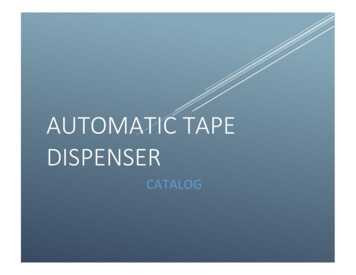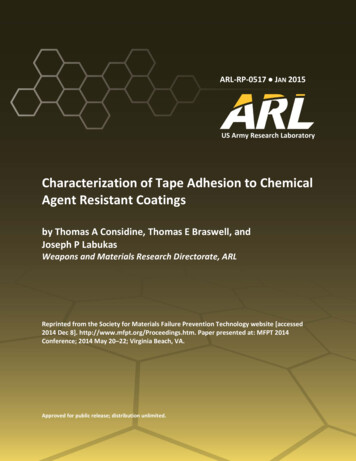
Transcription
ARL-RP-0517 JAN 2015US Army Research LaboratoryCharacterization of Tape Adhesion to ChemicalAgent Resistant Coatingsby Thomas A Considine, Thomas E Braswell, andJoseph P LabukasWeapons and Materials Research Directorate, ARLReprinted from the Society for Materials Failure Prevention Technology website [accessed2014 Dec 8]. http://www.mfpt.org/Proceedings.htm. Paper presented at: MFPT 2014Conference; 2014 May 20–22; Virginia Beach, VA.Approved for public release; distribution unlimited.
NOTICESDisclaimersThe findings in this report are not to be construed as an official Department of theArmy position unless so designated by other authorized documents.Citation of manufacturer’s or trade names does not constitute an officialendorsement or approval of the use thereof.Destroy this report when it is no longer needed. Do not return it to the originator.
ARL-RP-0517 JAN 2015US Army Research LaboratoryCharacterization of Tape Adhesion to ChemicalAgent Resistant Coatingsby Thomas A Considine, Thomas E Braswell, andJoseph P LabukasWeapons and Materials Research Directorate, ARLReprinted from the Society for Materials Failure Prevention Technology website [accessed2014 Dec 8]. http://www.mfpt.org/Proceedings.htm. Paper presented at: MFPT 2014Conference; 2014 May 20–22; Virginia Beach, VA.Approved for public release; distribution unlimited.
Form ApprovedOMB No. 0704-0188REPORT DOCUMENTATION PAGEPublic reporting burden for this collection of information is estimated to average 1 hour per response, including the time for reviewing instructions, searching existing data sources, gathering and maintaining thedata needed, and completing and reviewing the collection information. Send comments regarding this burden estimate or any other aspect of this collection of information, including suggestions for reducing theburden, to Department of Defense, Washington Headquarters Services, Directorate for Information Operations and Reports (0704-0188), 1215 Jefferson Davis Highway, Suite 1204, Arlington, VA 22202-4302.Respondents should be aware that notwithstanding any other provision of law, no person shall be subject to any penalty for failing to comply with a collection of information if it does not display a currentlyvalid OMB control number.PLEASE DO NOT RETURN YOUR FORM TO THE ABOVE ADDRESS.1. REPORT DATE (DD-MM-YYYY)2. REPORT TYPE3. DATES COVERED (From - To)January 2015ReprintDecember 2011–May 20144. TITLE AND SUBTITLE5a. CONTRACT NUMBERCharacterization of Tape Adhesion to Chemical Agent Resistant Coatings5b. GRANT NUMBER5c. PROGRAM ELEMENT NUMBER6. AUTHOR(S)5d. PROJECT NUMBERThomas A Considine, Thomas E Braswell, and Joseph P Labukas5e. TASK NUMBER5f. WORK UNIT NUMBER7. PERFORMING ORGANIZATION NAME(S) AND ADDRESS(ES)8. PERFORMING ORGANIZATION REPORT NUMBERUS Army Research LaboratoryATTN: RDRL-WMM-CAberdeen Proving Ground, MD 21005-5069ARL-RP-05179. SPONSORING/MONITORING AGENCY NAME(S) AND ADDRESS(ES)10. SPONSOR/MONITOR'S ACRONYM(S)11. SPONSOR/MONITOR'S REPORT NUMBER(S)12. DISTRIBUTION/AVAILABILITY STATEMENTApproved for public release; distribution is unlimited.13. SUPPLEMENTARY NOTESReprinted from the Society for Materials Failure Prevention Technology website [accessed 2014 Dec 8].http://www.mfpt.org/Proceedings.htm. Paper presented at: MFPT 2014 Conference; 2014 May 20–22; Virginia Beach, VA.14. ABSTRACTAdvanced military coating technologies have incorporated chemical agent resistance, desirable mechanical properties, andcorrosion mitigating properties into CARC systems currently in use. The performance of these coatings is evaluated usingMIL-DTL-530721. During the coating application phase and in the field, a tape pull off test is required by MIL-DTL-53072 togauge adhesive strength of a coating to a primer or substrate. We have investigated the chemical and physical interactions of avariety of tapes used for the verification of coating adhesion with ASTM D33592 on several substrates using tensile pulltesting, infrared-spectroscopy, and contact-angle measurements. A correlation between tape adhesion and surface wettingcharacteristics has been established. Tapes meeting the minimum performance parameters of 80 inch ounce-force over theselected CARC systems were indentified.15. SUBJECT TERMSCARC, coatings, coating adhesion, ASTM D3359, cross hatch, surface wetting, tape adhesion16. SECURITY CLASSIFICATION OF:a. REPORTb. ABSTRACTc. THIS PAGEUnclassifiedUnclassifiedUnclassified17. LIMITATIONOF ABSTRACT18. NUMBEROF PAGESUU2619a. NAME OF RESPONSIBLE PERSONThomas A Considine19b. TELEPHONE NUMBER (Include area code)410-306-2564Standard Form 298 (Rev. 8/98)Prescribed by ANSI Std. Z39.18ii
CHARACTERIZATION OF TAPE ADHESION TO CHEMICAL AGENTRESISTANT COATINGSThomas A. Considine, Thomas E. Braswell, and Joseph P. Labukas4600 Deer Creek LoopAberdeen Proving Ground, MD 21005Telephone: t: Advanced military coating technologies have incorporated chemical agentresistance, desirable mechanical properties, and corrosion mitigating properties intoCARC systems currently in use. The performance of these coatings is evaluated usingMIL-DTL-530721. During the coating application phase and in the field, a tape pull offtest is required by MIL-DTL-53072 to gauge adhesive strength of a coating to a primer orsubstrate. We have investigated the chemical and physical interactions of a variety oftapes used for the verification of coating adhesion with ASTM D33592 on severalsubstrates using tensile pull-testing, infrared-spectroscopy, and contact-anglemeasurements. A correlation between tape adhesion and surface wetting characteristicshas been established. Tapes meeting the minimum performance parameters of 80 inchounce-force over the selected CARC systems were indentified.Keywords: CARC; Coatings; Coating Adhesion; ASTM D3359; Cross Hatch; SurfaceWetting; Tape AdhesionIntroduction: Under regulation AR 750-13, Army based ground equipment must have afull Chemical Agent Resistant Coating (CARC) system as defined in MIL-DTL-53072,“CHEMICAL AGENT RESISTANT COATING (CARC) SYSTEM APPLICATIONPROCEDURES AND QUALITY CONTROL INSPECTION”. Several performance testrequirements for CARC are specified in MIL-DTL-53072. One such performancerequirement is adhesion testing of the system in accordance with ATSM D3359 MethodsA and B, “Standard Test Methods for Measuring Adhesion by Tape Test”. The primarytest for coating adhesion is the cross-hatch tape adhesion method described in ASTMD3359 Method B. Applicators of CARC at OEM’s, depots, and suppliers can provideobjective quality evidence (OQE) that the integrity of the CARC adhesion is within theestablished limits of MIL-DTL-53072.Recently, reports from the users in the field indicate that there is a significant fault withthe tape adhesion testing used on Army assets4,5. More specifically, many of the tapesthat are currently used in dry adhesion testing of CARCs reportedly do not adhere well toCARC topcoats containing polymer-beads used for gloss reduction6,7. In prior revisionsof ASTM D3359 a single tape was specified for use in adhesion testing. Withoutadequate tape adhesion to the CARC surface, false positive results of satisfactory CARCadhesion to the substrate can easily result in unacceptable fielded materiel, thereby1
MFPT 2014 Proceedingsexposing the warfighter to significant risk of IR detection and a coating system that is nolonger resistant to chemical agents. To emphasize the problem more clearly, a schematicrepresentation of a tape pull-off test on identical substrates with different tapes is shownin Figure 1. The performance specification, MIL-DTL-53072 does not specify the type oftape that should be used for adhesion testing or the required peel strength needed to verify thecoating adhesion. In order to mitigate this risk, it would require the closing of thetechnology gap by identifying suitable tapes for dry adhesion testing and developing afundamental understanding of their adhesive properties with respect to various CARCsurfaces.Figure 1: Diagram displaying differences in tapes used in cross hatch adhesionIn this research, the adhesion of several commercially available tapes to various CARCsurfaces was evaluated. These tapes were selected based on interviews with severalOEMs and military coating applicators as to which are commonly used in the field foradhesion testing8,9,10. The CARC formulations were varied to investigate the relationshipbetween the tapes and the different types of CARC’s available for use by OEM’s anddepots. More specifically, each tape was tested on water dispersible and solvent bornepolyurethane topcoats in the two most common colors (Green 38311 and 686A Tan12) thatwere prepared and provided by four different paint manufacturers. Attenuated totalreflectance Fourier transform infrared spectroscopy (ATR-FTIR) was used to investigatechemical differences in the adhesives used for each tape. Advancing water contact angleswere measured to provide insight on variations in the surface energies of various CARCsand the adhesive backing on the tapes.Performance criterion for tape adhesion has been set by the CARC Commodity Managerat 80 inch ounce-force using IAW ASTM D 3330, Peel Adhesion of Pressure SensitiveTape, which used a 180 degree pull angle and 1-inch wide tape 13 Tapes that meet orexceed the 80 inch ounce-force minimum on CARC systems will be recognized by ARLfor qualifying the adhesion strength at interfaces within the CARC system. Typically,adhesion throughout the various interfaces in this system is verified using IAW ASTM D3359.2
MFPT 2014 ProceedingsThat the governing specification for tape adhesion testing has become less precise withrespect to what tapes are acceptable for use which has created an opening for manydifferent types and brands of tapes with varied adhesive compositions. These variationsin tape adhesive composition can lead to differences in adhesion to a substrate. CARCformulations within the same specification vary between manufacturers and because ofthis, not all CARCs have similar surface energies. We hypothesize that the widevariation in surface energy of CARCs affects adhesion between various tapes and thesubstrate.Experimental:CARC coated substrates were tested as received from the manufacturers.summarizes the manufacturer, specification, type, color, and extender.Table 1: IVMIL-DTL-64159BISherwin WilliamsSpectrum3ColorGreen 383686A TanGreen 383686A TanGreen 383686A TanGreen 383686A TanGreen 383686A TanGreen 383686A TanGreen 383686A TanGreen 383686A TanGreen 383686A TanGreen 383686A TanGreen 383686A TanGreen 383686A TanGreen 383686A TanExtenderSilica Particles/FlakePolymer BeadsSilica Particles/FlakePolymer BeadsPolymer BeadsSilica Particles/FlakeSilica Particles/FlakePolymer BeadsSilica Particles/FlakePolymer BeadsSilica Particles/FlakePolymer BeadsPolymer BeadsTable 1
MFPT 2014 ProceedingsTapes were used as received from the manufacturers.manufacturer and type of tape used in this work.Table 2 summarizes theTable 2: Tape InformationManufacturer3M3MIntertapeSEMicroProduct Name250 Flatback Masking Tape396 Super Bond Polyester Film TapeLA-26 Polyester/Rope-Fiber Laminate TapeCross Hatch Tape (CHT)Adhesive TypeRubberRubber ResinThermosetting RubberSynthetic RubberCost/roll 55 13 16 35An Instron model #8871 load frame mechanical test system was used to measure pull-offforces of the different tapes on various CARC surfaces. The Instron was equipped with a /- 5kN dynamic load cell, a 90 panel clamping apparatus, and a pulling arm whichgripped and performed the 180 tape pull. The Instron was connected to a personalcomputer (PC). This PC served as both digital controller and data logger. A picture ofthe experimental set-up is shown in Figure 2. The tape was pressed onto the CARCsurface using an applicator in accordance with ASTM D3359. A suitable length of tapewas used to cross the surface of the test panel and double back 180 up into the testfixture. A photo of this can be seen in Figure 3. Air bubbles were removed from thetape/surface interface by applying an even pressure with the backside of a plastic spoonuntil no air pockets could be seen. A common plastic spoon was selected and a limit of 10seconds was established to remove air pockets so as to make every application asconsistent as possible and to establish an accommodating reference for future fieldapplications. The tape covered sample was clamped into place on the panel mount at thebase of the Instron. After the test panel was properly secured, and tape attached to thetape pull apparatus, the tape was pulled from the surface over 25mm at a rate of125mm/s. A total of 18 pulls were collected for each coating specification, type, color,and vendor tested. All data was recorded utilizing the Instron WaveMatrix14 softwaresuite and output to excel files.4
MFPT 2014 ProceedingsTape Pull ApparatusPanel MountFigure 2: Instron load frame, panel mount, and tape pull apparatusFigure 3: Close-up of panel mount and tape pull apparatus.5
MFPT 2014 ProceedingsA Nexus 870 (Thermo-Nicolet) FTIR spectrophotometer was fitted with a Gateway ATRaccessory (Specac). The accessory was allowed to purge with dry nitrogen for 10minutes prior to collecting a background spectrum of the ZnSe crystal that was mountedin the accessory. Tape was applied onto the crystal and air bubbles were removed withfinger pressure. The entire assembly was placed onto the ATR accessory through thesliding window in the FTIR sample compartment. The accessory compartment waspurged with N2 for 10 min prior to collecting the spectrum. The spectra were thesummation of 32 scans collected between 650 and 4000 cm-1 at a 2 cm-1 resolution.Advancing contact angles were measured using a Rame-
surface using an applicator in accordance with ASTM D3359. A suitable length of tape was used to cross the surface of the test panel and double back 180 up into the test fixture. A photo of this can be seen in Figure 3. Air bubbles were removed from the . 2) ) (). . . . . Characterization of Tape Adhesion to Chemical Agent Resistant Coatings .
